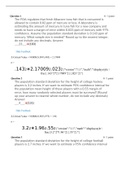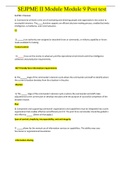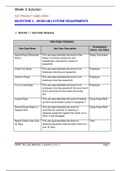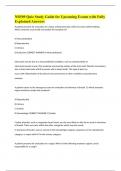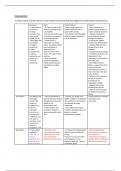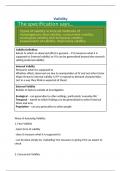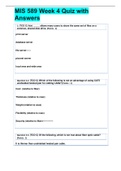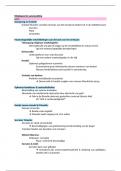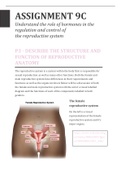Module 2: Case Study Design
Why picking a case study?
Case study research is a qualitative research method that involves in-depth analysis of a single case
or a few selected cases, such as an individual, a group, an organization, an event, or a
phenomenon. With the aim to gain comprehensive understanding of the case/s. Typically involves
multiple sources of data: interviews, observations, documents, and artifacts. There are a few types
of case studies, descriptive, exploratory, explanatory, with each their strengths and weaknesses.
Pros: ability to provide rich and detailed insights into complex phenomena
Cons: research is limited by its small sample size and lack of generalizability to other cases or
populations.
Chapter 1 Creswell & Creswell
Case study
Case studies are an approach to selecting research objects -> who/what will you study
It is not a method of data collection in itself
You can do a case study with a survey questionnaire
- Way of thinking about the setting in which you want to do your research
- Few research units (focus on: people, organizations, places, events)
- In depth understanding of what is going on
- Triangulation to verify your findings ( to look at the same objects of research)
- On site
- Various forms of data collection are possible (survey, interview,…)
- N is low (organizations, people)
Types:
- Single case (example: how Schiphol deals with the municipality: there is only 1 Schiphol)
- Multiple case (more airports in Europe)
- Comparative case (comparing airport Eindhoven with Schiphol)
But:
Contextualize
Focus is difficult
Quality is hard to monitor (comparability)
Strong: internal validity (if operationalized well) Weaker: External validity, Replications
,Lecture 1: Case Study Design + Web Lecture 1.1
Defining Case Study Research
Research Strategy: Case Study
Pros: One of the most used in research because it can provide rich data and interesting findings
Cons: more difficult to write down and time intensive research strategy
Defining case study research
Case study is “a strategy for doing research which involves an empirical investigation of a particular
contemporary (happening now) phenomenon (something that is going on: can be a person,
organization, event, place) within its real life context (a phenomenon within its context) using
multiple sources of evidence” (Robson, 1993)
- You go out there wherever the phenomenon is happening and study it within the context.
- You use multiple sources of evidence
- Qualitative field (qualitative data generations: interviews, observations, participant
observation but also documents)
- Talk to people, observe them and collect documents they keep about their activities)
Case study is “an intensive study of a single case or a small number of cases that promises to shed
light on a larger population of cases (Gerring and cojocaru, 2016).
- Intensive and systematic investigation of a phenomenon
- The idea behind it is that we can say something about a larger population of cases
A case: A case connotes a spatially bounded phenomenon/ “plot.
Example: municipality, political party, public organization, or person observed at a single point in
time or over some delimited period of time
A population: A population is comprised of a “sample” (=studied cases), as well as unstudied cases.
A sample: A sample is comprised of one “case” or several “cases” and each case is observed at
discrete points in time. Sample = studied cases
Example: Why do citizens protest turn violent? (case Rotterdam corona manifestations,
storming of parliament in Washington/ Brazil).
Why study the case in Rotterdam and not in Washington? -> Because this case is exceptional,
everyone had to deal with the measurements but why did it turn violent in Rotterdam?
Case Victor Leborgne: (impaired speech but intact comprehension)
In the 19th century: language function
Distributed through the brain
,Leborgne lost his speech and could in the end only speak out a single world. Examination by Broca of
Leborgne’s brain showed that part of his left frontal lobe was damaged (Broca’s area). Broca’s area =
responsible for speech production.
A case of psychiatric illness (phenomenon of interest)
Empirical situation/practice (empirical instance: case -> concept)
Violent coronavirus protests in Rotterdam (in 2021) -> What is it a case of? -> citizen protests ->
research question: why do citizen protests turn violent?
Y= violent citizen protests= phenomenon of interest
Exploratory research: identifying factors that cause Y
Theoretical interest: (concept -> empirical instance; case)
Political crises: role of administrators in political crisis
Research question: how do administrators navigate political crises? -> demarcation: not in the past,
but in the current political landscape (time); in the Netherlands (space) -> what is/are a case(s)
herof? -> political crisis in Amsterdam after the resignation of alderman U. in 2019
Case selection & justification
Before you take off… its good to think through what you aim for in your study (bearing in mind
scientific knowledge about your phenomenon of interest)
Description (descriptive) (interpretive approaches)
Get an understanding of how things go (descriptive), what matters, without aiming for causal claims
(narrative)
To identifying patterns (exploratory)
Get an understanding of how things connect (f.i. co-evolution, sequence, co-occurrence)
To making or reinforcing causal claims (explanatory) (towards more positivist approaches)
, Value of case study for scientific knowledge production (scientific value: what does it bring us?)
Justifying case study research is not easy because it is often criticized that it does not bring
generalizable results. (What can we learn from this specific case in relation to the broader universe of
similar cases?)
Arguments why case studies are valuable:
- Context-dependent knowledge: the fact that it is contextual is that makes the knowledge
gathered through case studies to valuable, because context can greatly impact how things
play out and what factors are at play. For example by examining the specific context in which
an event or situation occurred, case studies can provide valuable insights that may not be
apparent through more general or abstract analyses.
- Force of example: grasp of how people lives, but heavily depends on the selection of cases.
Helps dealing/understanding with complex problems that are hard to understand by
examining a real world example.
In depth understanding of ambiguities and complexities of real world: case studies give
greater inside in the complexity and contradictions of real life. It can provide a deeper
understanding of the factors that contributed to particular outcomes. It is exactly the deep
details that communicates what is really going on in the real world that is so valuable. Good
to help making better decisions and avoid common pitfalls.
Key considerations in case study research (1): fit with research question
Before embarking in case study research: Make sure this strategy fits your research question and
methodological choices (interpretive-qual; pos-qual)
Case study research fits any kind of research
- Descriptive (because it can examine the relationship between variables)
- Exploratory (because it can give you those initial insights in to the phenomenon that you
need withing exploratory research)
- Explanatory (it allows you to explain why the phenomenon is happening, helps explain the
causal relationship/mechanism)
Key considerations in case study research (2) case selection
- Single case study? e.g. implementation of the environmental and planning act in Rotterdam
- Multiple case study? e.g. implementation of the environmental and planning act in five
municipalities (Utrecht, Eindhoven, Rotterdam, Amsterdam, Den Haag)
Always challenging to justify your choice of case/s -> strategic consideration
If the results are generalizable towards a larger population depends on the strategic selection of
cases of composing the sample.
Why picking a case study?
Case study research is a qualitative research method that involves in-depth analysis of a single case
or a few selected cases, such as an individual, a group, an organization, an event, or a
phenomenon. With the aim to gain comprehensive understanding of the case/s. Typically involves
multiple sources of data: interviews, observations, documents, and artifacts. There are a few types
of case studies, descriptive, exploratory, explanatory, with each their strengths and weaknesses.
Pros: ability to provide rich and detailed insights into complex phenomena
Cons: research is limited by its small sample size and lack of generalizability to other cases or
populations.
Chapter 1 Creswell & Creswell
Case study
Case studies are an approach to selecting research objects -> who/what will you study
It is not a method of data collection in itself
You can do a case study with a survey questionnaire
- Way of thinking about the setting in which you want to do your research
- Few research units (focus on: people, organizations, places, events)
- In depth understanding of what is going on
- Triangulation to verify your findings ( to look at the same objects of research)
- On site
- Various forms of data collection are possible (survey, interview,…)
- N is low (organizations, people)
Types:
- Single case (example: how Schiphol deals with the municipality: there is only 1 Schiphol)
- Multiple case (more airports in Europe)
- Comparative case (comparing airport Eindhoven with Schiphol)
But:
Contextualize
Focus is difficult
Quality is hard to monitor (comparability)
Strong: internal validity (if operationalized well) Weaker: External validity, Replications
,Lecture 1: Case Study Design + Web Lecture 1.1
Defining Case Study Research
Research Strategy: Case Study
Pros: One of the most used in research because it can provide rich data and interesting findings
Cons: more difficult to write down and time intensive research strategy
Defining case study research
Case study is “a strategy for doing research which involves an empirical investigation of a particular
contemporary (happening now) phenomenon (something that is going on: can be a person,
organization, event, place) within its real life context (a phenomenon within its context) using
multiple sources of evidence” (Robson, 1993)
- You go out there wherever the phenomenon is happening and study it within the context.
- You use multiple sources of evidence
- Qualitative field (qualitative data generations: interviews, observations, participant
observation but also documents)
- Talk to people, observe them and collect documents they keep about their activities)
Case study is “an intensive study of a single case or a small number of cases that promises to shed
light on a larger population of cases (Gerring and cojocaru, 2016).
- Intensive and systematic investigation of a phenomenon
- The idea behind it is that we can say something about a larger population of cases
A case: A case connotes a spatially bounded phenomenon/ “plot.
Example: municipality, political party, public organization, or person observed at a single point in
time or over some delimited period of time
A population: A population is comprised of a “sample” (=studied cases), as well as unstudied cases.
A sample: A sample is comprised of one “case” or several “cases” and each case is observed at
discrete points in time. Sample = studied cases
Example: Why do citizens protest turn violent? (case Rotterdam corona manifestations,
storming of parliament in Washington/ Brazil).
Why study the case in Rotterdam and not in Washington? -> Because this case is exceptional,
everyone had to deal with the measurements but why did it turn violent in Rotterdam?
Case Victor Leborgne: (impaired speech but intact comprehension)
In the 19th century: language function
Distributed through the brain
,Leborgne lost his speech and could in the end only speak out a single world. Examination by Broca of
Leborgne’s brain showed that part of his left frontal lobe was damaged (Broca’s area). Broca’s area =
responsible for speech production.
A case of psychiatric illness (phenomenon of interest)
Empirical situation/practice (empirical instance: case -> concept)
Violent coronavirus protests in Rotterdam (in 2021) -> What is it a case of? -> citizen protests ->
research question: why do citizen protests turn violent?
Y= violent citizen protests= phenomenon of interest
Exploratory research: identifying factors that cause Y
Theoretical interest: (concept -> empirical instance; case)
Political crises: role of administrators in political crisis
Research question: how do administrators navigate political crises? -> demarcation: not in the past,
but in the current political landscape (time); in the Netherlands (space) -> what is/are a case(s)
herof? -> political crisis in Amsterdam after the resignation of alderman U. in 2019
Case selection & justification
Before you take off… its good to think through what you aim for in your study (bearing in mind
scientific knowledge about your phenomenon of interest)
Description (descriptive) (interpretive approaches)
Get an understanding of how things go (descriptive), what matters, without aiming for causal claims
(narrative)
To identifying patterns (exploratory)
Get an understanding of how things connect (f.i. co-evolution, sequence, co-occurrence)
To making or reinforcing causal claims (explanatory) (towards more positivist approaches)
, Value of case study for scientific knowledge production (scientific value: what does it bring us?)
Justifying case study research is not easy because it is often criticized that it does not bring
generalizable results. (What can we learn from this specific case in relation to the broader universe of
similar cases?)
Arguments why case studies are valuable:
- Context-dependent knowledge: the fact that it is contextual is that makes the knowledge
gathered through case studies to valuable, because context can greatly impact how things
play out and what factors are at play. For example by examining the specific context in which
an event or situation occurred, case studies can provide valuable insights that may not be
apparent through more general or abstract analyses.
- Force of example: grasp of how people lives, but heavily depends on the selection of cases.
Helps dealing/understanding with complex problems that are hard to understand by
examining a real world example.
In depth understanding of ambiguities and complexities of real world: case studies give
greater inside in the complexity and contradictions of real life. It can provide a deeper
understanding of the factors that contributed to particular outcomes. It is exactly the deep
details that communicates what is really going on in the real world that is so valuable. Good
to help making better decisions and avoid common pitfalls.
Key considerations in case study research (1): fit with research question
Before embarking in case study research: Make sure this strategy fits your research question and
methodological choices (interpretive-qual; pos-qual)
Case study research fits any kind of research
- Descriptive (because it can examine the relationship between variables)
- Exploratory (because it can give you those initial insights in to the phenomenon that you
need withing exploratory research)
- Explanatory (it allows you to explain why the phenomenon is happening, helps explain the
causal relationship/mechanism)
Key considerations in case study research (2) case selection
- Single case study? e.g. implementation of the environmental and planning act in Rotterdam
- Multiple case study? e.g. implementation of the environmental and planning act in five
municipalities (Utrecht, Eindhoven, Rotterdam, Amsterdam, Den Haag)
Always challenging to justify your choice of case/s -> strategic consideration
If the results are generalizable towards a larger population depends on the strategic selection of
cases of composing the sample.


